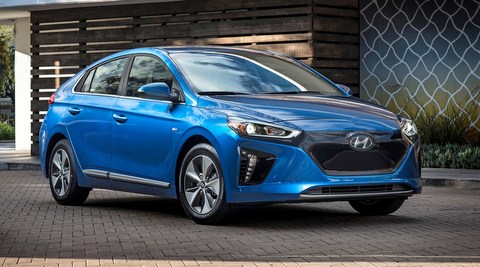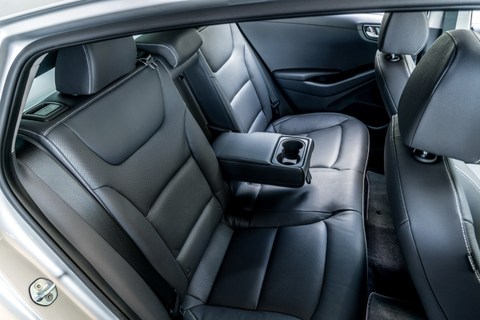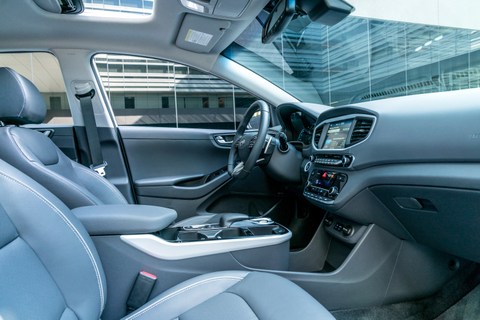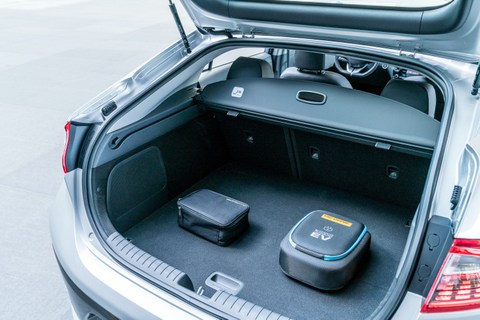Easy to Live With
As the electric car market grows, Hyundai is quietly, determinedly, building a wider assortment of choices. The 2019 Hyundai Ioniq is the brand’s direct competition with the ubiquitous Toyota Prius; it comes as a hybrid, plug-in-hybrid or pure electric. You can identify the EV by its big black grilleless nose, unique headlamps and taillamps, and its own custom alloy wheels.

My Black Noir Pearl test car was the all-electric model. Since its debut as a 2017, the Ioniq has made the case for how easy an EV is to live with. Not as outlandishly styled as the Prius, it employs the same teardrop shape and clever wind-cheating tricks to get an aerodynamic 0.24 cd, slipping smoothly through the air.
The Ioniq EV’s 88 kW motor equates to just 118 horsepower, but with a generous 218 pounds-feet of torque, the 3,285-pound EV scoots along fine in traffic and never leaves you feeling frustrated. Hyundai brags that the Ioniq EV is the “most efficient electric vehicle sold in America” at 136 MPGe combined (150 city, 122 highway). Compare that to other EVs, such as the Chevrolet Bolt EV, at 119 MPGe combined and the new Nissan Leaf at 108 MPGe.
Efficient But Lacking Range
Range is a big issue with EVs, and that’s where the Ioniq EV isn’t ideal. It has 124 miles of range, which is actually plenty for nearly everything most people do. But—if you want to travel 350 miles at the holidays to visit your aunt in the next state, you’d better plan to take a couple of long rest stops. At least the Ioniq comes with standard DC fast-charging.

The Ioniq’s 28 kilowatt-hour (kWh) lithium-ion polymer battery is under the rear seat, so it doesn’t intrude that much on cargo space—you get a useful 23 cubic feet. The polymer in the battery means it’s easier to shape to fit in specific areas. The range math is easy to do: a Chevrolet Bolt has a 60-kWh battery and earns an EPA range of 238 miles vs. 124 for the 28 kWh Ioniq EV.
As an all-electric vehicle, the Ioniq Electric gets perfect 10’s from the EPA for Smog and Greenhouse Gas. With electricity much cheaper than gas, you’ll spend only about $500 a year on fuel.
Choose Your Regen
One way that electric vehicles extend range is by regenerative braking. In most EVs, you can have either a lot of regeneration or none. Having it “on” means you can slow down and sometimes even stop without using the brake pedal. In the Ioniq Electric, as with other Hyundai and sister Kia EVs, you can set regeneration to four levels, from 0 to 3, with 3 being the strongest.

There are two trim levels – base and Limited. My tester, as a Limited, enjoyed the benefits of everything from chrome outside moldings to HID headlights, a power sunroof, a heat pump (great in an electric car), 10-way power driver’s seat, leather upholstery, BlueLink Guidance Package, fancy door sill plates and a premium eight-speaker Infinity audio system.
Besides the luxury and convenience stuff, the Limited includes a package of electronic features that make it a much safer ride. These include blind spot detection with rear traffic alert (this feature has saved me numerous times over the last few years), automatic emergency braking with pedestrian detection, and lane keep assist (noisy, but keeps you in your lane). You also get the convenience of smart cruise control (not available on any Bolt EV) and headlights with Dynamic Bending Light that can “see around corners.” And don’t forget about driver attention warning to keep you aware.
Base Has the Same Powertrain
The mechanicals are the same in base and Limited, and the base still has loads of fine features so, if you can manage with less, you can save a cool six grand. The base car starts at $31,200 while the Limited is $37,200. Both prices include shipping, and both qualify for California (and other state) rebates and Federal tax credits, so the actual price could be as much as $10,000 less if you buy.

Hyundai now offers the small Kona crossover as an EV, the Sonata large midsize sedan as a plug-in hybrid, and even the all-new Nexo hydrogen fuel cell vehicle. It’s a pretty impressive lineup, and you get the advantage of style directed by the former Audi chief designer, Peter Schreyer. Hyundais are better looking than Audis these days!
Built in Ulsan, Korea of 91 percent Korean parts, the Ioniq Electric is well-designed and well-made, as the brand picks up good stats in the J.D. Power surveys for initial quality. For 2018, Hyundai came in third, ahead of Porsche and just behind siblings Kia and Genesis.
Other than its limited range, there’s absolutely no reason you can’t live contentedly with a Hyundai Ioniq Electric.
Related Stories You Might Enjoy—Kia & Hyundai Plug-in News & Reviews
NY Auto Show: Kia HaBaNiro: the Everything Concept
Road Test: 2019 Kia Niro EV (Steve’s view)
Road Test: 2019 Kia Niro EV (John’s view)
Road Test: 2018 Hyundai Ioniq PHEV (Steve’s view)
News: Kia + Amazon Link for Home Charging
News: 2018 Hyundai Sonata PHEV Price Cut, Range Increase
Road Test: 2018 Kia Optima PHEV
Road Test: 2018 Hyundai Ioniq PHEV (John’s view)
LA Auto Show: 2020 Kia Soul EV Debuts
News: 2019 Hyundai Kona EV Revealed
Road Test: 2018 Kia Niro PHEV (John’s view)
Road Test: 2018 Kia Niro PHEV (Steve’s view)
Make sure to opt-in to the Clean Fleet Report newsletter (top right of page) to be notified of all new stories and vehicle reviews.
Disclosure:
Clean Fleet Report is loaned free test vehicles from automakers to evaluate, typically for a week at a time. Our road tests are based on this one-week drive of a new vehicle. Because of this we don’t address issues such as long-term reliability or total cost of ownership. In addition, we are often invited to manufacturer events highlighting new vehicles or technology. As part of these events we may be offered free transportation, lodging or meals. We do our best to present our unvarnished evaluations of vehicles and news irrespective of these inducements.
Our focus is on vehicles that offer the best fuel economy in their class, which leads us to emphasize electric cars, plug-in hybrids, hybrids and diesels. We also feature those efficient gas-powered vehicles that are among the top mpg vehicles in their class. In addition, we aim to offer reviews and news on advanced technology and the alternative fuel vehicle market. We welcome any feedback from vehicle owners and are dedicated to providing a forum for alternative viewpoints. Please let us know your views at publisher@cleanfleetreport.com.

12 thoughts on “Road Test: 2019 Hyundai Ioniq Electric”